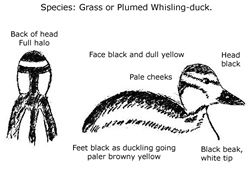Quote:
There are a few distinctive features in the Muscovy ducklings. Where the bill meets the head is different than other ducklings, hard to describe but that 3rd picture, taken bill on, sure looks like a Muscovy. Part of my problem is that I have no knowledge of YOUR native ducks. The other thing that sets the Muscovy duckling apart from our other domestics is that they hatch with needle sharp toe nails or claws. This is because they are tree ducks rather than puddle ducks. Their nests in the wild are usually in holes in trees and the ducklings need the claws to climb out of the nest and get to the ground for their first food.
The tails are distinctive too, they are unusually broad when grown, supposed to be a feature that allows better control for flying around trees. in ducklings the tail seems to be more active than other ducklings. it wags when they are happy or mad. about the only sime it is still is when they are scared and instinctively 'freeze'. If you were in the USA I would be sure that was a Muscovy But I don't know you could have similiar wild tree ducks for all I know.
As for them being a problem in the US, they are in our Southern (warmer) wet areas. They probably were native to the areas which formed the Nothern (colder) edge of their natural range. As we populated this area we killed off most of the natural preditors. Being an Australian you must know what happens when there is a shortage of preditors (Introduced Rabbits?) Muscovy aren't in the rabbit class of breeders but they try hard. Three hatches a year is pretty much the rule in warm areas and 18 ducklings/hatch is not unheard of. The mothers are good parents. The males love to breed, both sexes fly but in domestic settings the males often grow too heavy to fly. They don't migrate like other native ducks nor can they cross breed. I doubt your wild life people would allow importation now, they did in the past.
 As far as I know the Muscovy duck is a domesticated breed any way. That would be like saying a maltese dog is a nuisance... Oh wait, they are!
As far as I know the Muscovy duck is a domesticated breed any way. That would be like saying a maltese dog is a nuisance... Oh wait, they are!

 I know people who have kept only one duck - he was awesome! He hung out with their dogs, and would go in the house with them. I've always had more ducks, but right now I only have 2. I agree, apologizing is a great idea
I know people who have kept only one duck - he was awesome! He hung out with their dogs, and would go in the house with them. I've always had more ducks, but right now I only have 2. I agree, apologizing is a great idea


 Wagging tails is a good thing... "Mom, I'm happy!!"
Wagging tails is a good thing... "Mom, I'm happy!!"
















